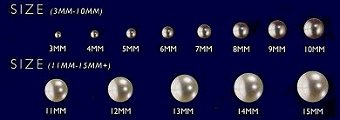Pearl Evaluation

Pearls are classified by origin, then graded by
- Lustre: Intensity of light reflected from pearl's surface
- Surface clarity: Blemishes usually confined to the surface of the pearl
- Shape: Round, near Round, Oval, Button, Semi-baroque, Baroque
- Color: Ranges from white through various tints to black
- Size: Measured in millimeters
- Nacre thickness: Noted if the nucleus is visible or a dull, chalky surface
- Matching: uniformity of appearance in strands and multi-pearl pieces
These qualities are not considered equal. Some factors will be weighted to give them more influence in arriving at a final grade. A very thin nacre thickness, for example, could never yield a fine quality pearl.
Grading is relative to the best attainable quality for the type. For example, South Sea pearls, which grow in warmer water for longer periods of time, generally have a lower luster and more tiny blemishes than Japanese Akoya pearls, that grow in colder water and for shorter periods of time. South Sea pearls are graded against each other, not by what would be expected for a similar quality Akoya pearl.
Lustre

For cultured pearl experts, lustre is perhaps the most important indicator in evaluating cultured pearl quality. Lustre is what separates the inferior pearl from the superior and the ordinary from the extraordinary. Lustre is what many experts term the heart and soul of the sea-grown gem. Throughout history, this unique lustre has separated pearls from all other gems
Surface

Surface quality refers specifically to the abundance or absence of physical blemishes or flaws. When evaluating surface (the trade uses such terms as blemish, spotting and cleanliness), remember that cultured pearls are grown by live oysters in nature. As such, there are many uncontrollable forces that affect the surface.
Shape

Shapes range in descending order of value from round to semi-round, from off-round to oval and from drop to baroque. It's important to understand that in pearl industry lingo, generally the shapes from round to drop are pretty symmetrical, while anything baroque denotes a pearl that is completely asymmetrical or free-form. The aforementioned shapes usually occur in Japanese akoya cultured pearls as well as Tahitian, South Sea and freshwater pearls.
Color

Cultured pearls come in a variety of colors from rose to black. While the color of a pearl is really a matter of the wearer’s preference, usually rosé or silver/white pearls tend to look best on fair skins while cream and gold toned pearls are flattering to darker complexions.
Size

Cultured pearls are measured by their diameter in millimeters. They can be smaller than one millimeter in the case of tiny seed pearls, or as large as twenty millimeters for a big South Sea pearl. The larger the pearl, other factors being equal, the more valuable it will be.